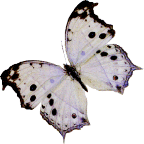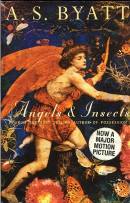
Mary Lynn Richardson
Part I of a two-part essay on Jungian paradigms in A.S. Byatt's novella "Morpho Eugenia," (published in Angels & Insects, Vintage Press, 1992), and filmed by Philip Haas in 1995 as Angels and Insects.

A.S. Byatt. Angels & Insects: Two Novellas. London: Vintage. 1992.
With a faithfulness to the inherent logic of her metaphors equaling Einstein's, A.S. (Toni) Byatt has written the novella "Morpho Eugenia ," from which the 1995 film, Angels and Insects, is made. While the novella offers greater conceptual satisfaction, and the film richer perceptual delight, each work is a masterpiece which, in its completed and highly complex form, stands as no less vital a metaphor than the analogical germ by which it was conceived. As a live oak differs from an acorn, a story has symbolic power greater than, yet intrinsically related to, its central plot. Just so Morpho Eugenia, grown from the analogous conjugation of insects and humans into the story of a complex Victorian household with a shameful secret at its core, provides us with a new level of metaphor. And in the societal collective of this household -- and even more poignantly in the "shameful secret" at its core -- are patterns which resonate in peculiar precision with the "Jungian world": the community of those involved in Jungian analysis and societies such as this.
Of course it would be preposterous to suggest Byatt is aware of this, let alone intended to write a work metaphorically relevant in the consulting rooms of analytical psychologists -- just as preposterous as to suppose the medieval alchemists who produced the Rosarium philosophorum knew they were providing a paradigm (elaborated by Jung in Psychology of the Transference) which would be empirically confirmed in this same 20th century context. Like all works of integral clarity, "Morpho Eugenia" mirrors many aspects of our human condition, sociological and psychological. Here I shall look briefly at how the story illumines the individual in collective complexes; in the next newsletter I shall address the shameful secret at the core of "Morpho Eugenia", and consider how an analogous secret is spontaneously recreated in the alchemy of analysis.
Morpho eugenia, ("beautiful form"), is a species of rare and exquisite butterfly which hovers out of human reach in the Amazon jungle. The young naturalist William Adamson, sole survivor of a shipwreck in which the ten years of his life's work are lost, has arrived back in Victorian England with little but a preserved pair of these butterflies. Penniless and in shock, determined to return to the Amazon as soon as he may, Adamson makes his way to the great manor home of his patron, the Reverend Sir Harald Alabaster, who is wrestling with the theological implications of Darwin's recently published Origin of the Species. Here William is entranced by Sir Harald's ethereal eldest daughter, Eugenia, who hovers, seemingly unattainable, high above his small industrious working-class self. And yet, to his astonishment, he does capture her, marry her, and prick her to her bed in a manner the film portrays like a Playboy centrefold, and shows as visually analogous to the pinning of the prized Morphos to the silk cushion of their specimen case.
But has he captured her? Or is he himself captured? (Just so may we ask whether we possess our societal and psychological complexes, or they us?)
It is soon apparent to William that his role is to impregnate Eugenia; once she is gravid, he is neither needed nor wanted. Oh he is busy enough, monumentally so: Sir Harald has given him the task of organizing by Linnaean principles large crates of specimens collected higgledy-piggledy from all the uncivilized world. But this gargantuan labour, diligently and meticulously performed, is neither remunerated nor valued even by his patron, whose sole preoccupation is the writing of a philosophical work to conceptually resolve his existential angst. In this lengthy exegesis, reasoning by analogy with ants, Harald comes to ask, "What dictates the coherent movement of all the cells in my body? I do not, though I have Will, and Intelligence, and Reason. I grow, I decay, according to laws which I obey and cannot alter." Could it be there is a 'forma formativa' -- a Vital Force residing in the collective itself -- which determines our lives?
From the luxurious Alabaster complex William does ultimately escape, to return to his lifework in the mysteries and hardships of the Amazon. The means of his release comes largely through the diligence and practical intelligence of a femme inspiratrice, Matty Crompton, who holds no classifiable role within the household, and is notably lacking in beautiful form. But ultimately what frees William is his discovery of the shocking secret at the core of the household. Of this I shall speak in the next issue.
 Part
II: Formative Captivations
Part
II: Formative Captivations ![]()
* First published by Society News of the C.G. Jung Society of Calgary in Alberta 5(2):4 1996. Return
